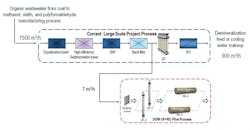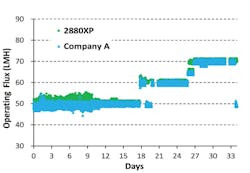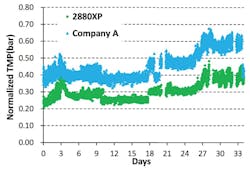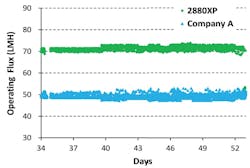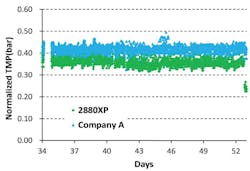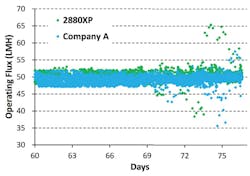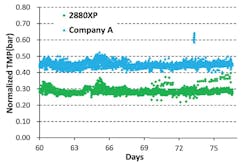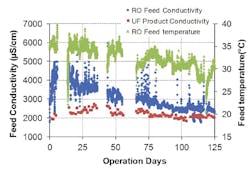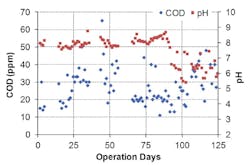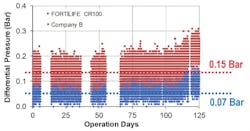Coal-to-chemical wastewater reuse
In recycling processes, wastewater has higher levels of salts and organic contaminants than freshwater sources, thus presenting a challenge to both ultrafiltration (UF) and reverse osmosis (RO) systems. For coal-to-chemical wastewater reuse, high levels of organics in the feedwater will result in membrane fouling for UF and RO systems, as seen by deterioration of membrane flux or trans-membrane pressure increase (for the UF system) or system differential pressure increase (for the RO system) over time.
To recover performance, the UF and RO systems must receive frequent cleaning via clean-in-place (CIP) processes to remove foulant.
Depending on the contamination level of the feedwater and the fouling resistance capability of the membranes, these CIP events can become so frequent that the system downtime impacts reliability as a source for purified water. Additionally, the cleaning chemicals, strong acids and strong caustics used during the CIP can potentially damage the membrane performance over time and reduce the lifetime of UF/RO modules.
To complement the global trend toward treating more challenging waters, advanced UF/RO membranes are needed to provide higher reliability and optimized performance.
Piloting facility overview for treating coal-to-chemical wastewater
To highlight the challenge of treating highly contaminated wastewater, here we’ll review an application from a coal-to-chemical manufacturing complex that collected wastewater in an equalization basin at 9.5 mgd. A high-efficiency sedimentation basin, biochemical aeration filter (BAF), sand filter, ultrafiltration and reverse osmosis system treated the wastewater. The permeate water from a wastewater RO system was recycled for use as demineralization feedwater or cooling water makeup water in the coal-to-chemical complex.
“The chemical oxygen demand (COD) in the feedwater was still 78 parts per million (ppm), indicating that most of the organics in the coal-to-chemical wastewater were refractory chemical compounds.”
Although several pretreatment steps were designed before the membrane system, the chemical oxygen demand (COD) in the feedwater was still 78 parts per million (ppm), indicating that most of the organics in the coal-to-chemical wastewater were refractory chemical compounds. The compounds were difficult to degrade by a general biological treatment like an anaerobic/oxic process. Scaling factors also existed in the wastewater, and anti-scalant was dosed in the feedwater of the industrial RO system to alleviate scaling precipitation problems.
Ultrafiltration
The impacts of operating flux, transmembrane pressure, and cleaning protocol were investigated in three experimental stages. The two ultrafiltration modules installed for each phase were a Dow module and a comparative module from Company A.
The feed turbidity of the UF system was not high (<10 NTU), but the feed COD was about 20 to 78 ppm, indicating the coal-to-chemical wastewater contained significant amounts of refractory chemical compounds, which presented potential fouling issues for both the ultrafiltration and RO system in the downstream process.
The same operating flux (50, 60 and 70 LMH) were examined in the UF pilot phase I. As shown in Figure 2(a), 50 LMH flux lasted 15 days, and the operating flux increased 10 LMH in the next two weeks, respectively. All the fluxes are stably controlled in the piloting phase I. Figure 2(b) shows the corresponding normalized trans-membrane pressure (TMP) at every operating flux. Attributed to the new ultrafiltration fiber chemistry, the Dow module showed about a 40 percent reduction on the normalized TMP, compared to the similar product from Company A.
The UF pilot phase II investigated the potential utilization of the low TMP of the Dow module. During this stage, the module ran at 40 percent higher operating flux, under which the operating condition of the module TMP was about 0.4 bar, similar to Company A. Pilot phase II successfully demonstrated how the module was able to provide a similar operation profile with 40 percent added production capacity.
In the pilot phase III, the reduced cleaning operation strategy was investigated for fewer chemical usage and less operational expenditure (OPEX). Both UF modules were operated at the same flux, and the low TMP was maintained by the Dow module over longterm operation, even with the chemical element balance frequency reduced by 50 percent.
Reverse osmosis
On the RO side of the application under consideration here, two 8040 RO elements were installed — one from Dow and a comparable element from Company B. Both RO elements were operated under the same permeate flow and recovery. The operating flux was designed based on the general wastewater reuse application guideline [1], which was about 16 to 18 L/m2hr. The element recovery was set to be 8 percent, which was aimed to simulate the lead element operating condition in the industrial RO system. Chemical cleaning was conducted after 120 days of operation to recover the element performance.
The differential pressure was a particularly important index when treating biofouling-prone feedwater. The biofouling always starts from the microorganism accumulation on the feed spacer and membrane surface. As the microorganism colony grows, its associated biofilm occupies the space in the feed channel and causes the system differential pressure to increase, especially for the lead element in the first stage. Figure 6 shows the differential pressure of the Dow element at about 0.07 Bar for the single element test, whereas the differential pressure of general elements (like Company B) was 0.15 Bar, under the same operating condition. It was also shown that the low differential pressure could be maintained for long-term operation, with the dew point increase of the Dow element slower than general RO elements.
“Since industrial water end users are facing more and more pressure to utilize contaminated water sources or reuse their own wastewater, membrane fouling for both UF and RO is an unavoidable topic and can result in unreliable operation, frequent offline chemical cleaning, and high energy consumption.”
Since industrial water end users are facing more and more pressure to utilize contaminated water sources or reuse their own wastewater, membrane fouling for both UF and RO is an unavoidable topic and can result in unreliable operation, frequent offline chemical cleaning, and high energy consumption. This article highlighted the field-test results of a Dow UF module and an RO element in a wastewater reuse application. In the experiments, the Dow ultrafiltration module provided the lowest TMP and highest flux operation with less cleaning required. Meanwhile, Dow’s RO element provided a low feed-concentrate pressure drop and reduced flux loss, which translated to lower energy operations and fewer cleanings over the life of the element.
REFERENCES
- DOW FILMTEC™ Membranes. System Design: Membrane System Design Guidelines. http://www.dow.com/scripts/litorder.asp?filepath=liquidseps/pdfs/noreg/609-21010.pdf&pdf=true
- Dow Water & Process Solutions. ROSA System Design Software. http://www.Dow.com/en-us/water-and-process-solutions/resources/design-software/rosa-software. 2013,4.
Cheng Yang joined Dow Water & Process Solutions in July 2012 and currently serves the company as an application development engineer. He has been involved in multiple research & development (R&D) projects about fouling resistant RO, minimal liquid discharge, and special separations. Yang has two world patent submissions, is published in 12 journals, and holds a doctorate of Philosophy in Chemical Engineering from Tsinghua University, Beijing, China.
Tina Arrowood is a principal research scientist in Dow Water & Process Solutions’ reverse-osmosis membrane R&D group. She leads a research platform to study the fundamental science of fouling in RO systems to develop fouling resistant technologies. Arrowood holds a doctorate in Organic Chemistry from the University of Minnesota.
Andrea Lima is the Ultrafiltration business development manager in Dow Water & Process Solutions’ North America group. She started at Dow in 2011 in Latin America as an application development engineer, and in 2013, she relocated to Houston as the ultrafiltration technical service engineer. She has a degree in materials science engineering with a focus on effluent treatments.


